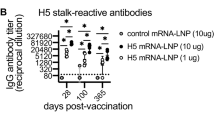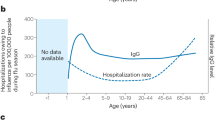Abstract
DISAPPOINTINGLY little is known about the mechanisms of natural, genetically determined resistance to infectious agents1. Even in the simplest situation, where a single, dominant gene is responsible for resistance to a group of closely related viruses, no satisfactory explanation of the phenomenon has been offered. A case in point is the resistance towards the lethal action of a number of myxoviruses, mainly influenza A, exhibited by the inbred mouse strain A2G and attributed to the presence of the dominant gene Mx (refs 2–5). Serial virus titrations in A2G and comparable susceptible mice showed that resistance must depend on an event occurring early in the infectious process, since by day 2 after challenge virus titres were significantly lower in resistant animals2. It was conceivable that an early triggering of the immune system might exert such an effect. If this were the case, one would expect the expression of the resistance gene to be impaired in mice showing profound disturbances of their immunological apparatus. Nude mice homozygous for the gene nu (refs 6–9) show such a disturbance, mainly of the T cell system. We have therefore introduced the gene MX into nu/nu mice, and we have investigated the progeny from appropriate crosses for the phenotypic expression of resistance to neurotropic influenza virus.
This is a preview of subscription content, access via your institution
Access options
Subscribe to this journal
Receive 51 print issues and online access
$199.00 per year
only $3.90 per issue
Buy this article
- Purchase on Springer Link
- Instant access to full article PDF
Prices may be subject to local taxes which are calculated during checkout
Similar content being viewed by others
References
Allison, A. C., Arch. Virusforsch., 17, 280–294 (1965).
Lindenmann, J., Lane, C. A., and Hobson, D., J. Immun., 90, 942–951 (1963).
Lindenmann, J., Proc. Soc. exp. Biol. Med., 116, 506–509 (1964).
Lindenmann, J., and Klein, P. A., Arch. Virusforsch., 19, 1–12 (1966).
Rusanova, N. A., and Soloview, V. D., Vop. Virus., 11, 398–402 (1966).
Pantelouris, E. M., Nature, 217, 370–371 (1968).
De Sousa, M. A. B., Parrott, D. M. V., and Pantelouris, E. M., Clin. exp. Immun., 4, 637–644 (1969).
Kindred, B., Eur. J. Immun., 1, 59–61 (1971).
Wortis, H. H., Clin. exp. Immun., 8, 305–317 (1971).
Pantelouris, E. M., and Hair, J., J. Embryol. exp. Morph., 24, 615–623 (1970).
Wortis, H. H., Nehlsen, S., and Owen, J. J., J. exp. Med., 134, 681–692 (1971).
Virelizier, J.-L., Postlethwaite, R., Schild, G. C., and Allison, A. C. (in the press).
Author information
Authors and Affiliations
Rights and permissions
About this article
Cite this article
HALLER, O., LINDENMANN, J. Athymic (nude) mice express gene for myxovirus resistance. Nature 250, 679–680 (1974). https://doi.org/10.1038/250679a0
Received:
Issue Date:
DOI: https://doi.org/10.1038/250679a0
This article is cited by
-
Host gene influences sensitivity to interferon action selectively for influenza virus
Nature (1980)
-
Resistance to HSV-1 in the mouse is governed by two major, independently segregating, non-H-2 loci
Immunogenetics (1980)
-
γ-Glutamyl transpeptidase in human nephroblastoma grown in nude mice
Experientia (1976)
-
Thymus dependence of viral antigens
Nature (1975)
Comments
By submitting a comment you agree to abide by our Terms and Community Guidelines. If you find something abusive or that does not comply with our terms or guidelines please flag it as inappropriate.



